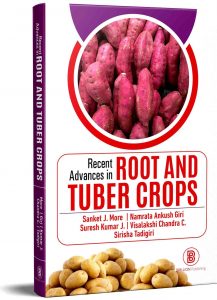Root and tuber crops (RTCs) were first domesticated several thousand years ago and eventually became a staple food for the poorest farmers and households of the tropical and subtropical countries. Currently, RTCs serve as
staple food (either primary form or modified form) for more than 2.2 billion population across the globe. RTCs are the third most important food crops after cereals and legumes. Potato along with cassava, sweet potato and yams rank among the top 15 crop plants of the world concerning cropping area. Potato is found in almost every household of the globe. Cassava is the most important root and tuber crop in the tropics where it is a primary staple food in many of the poorest countries, and the sweet potato is also a food staple in Asia, Africa and America. Yams are also important staple food crops in tropical and subtropical regions. Although Taro and Cocoyam are minor crops, they do provide staple food for poor people in Africa, Asia and America. Apart from the food source, RTCs serve as animal feed and fuel source. Conventional breeding methods have succeeded in improving productivity but modern breeding techniques have succeeded in reducing the breeding cycle to some extent. The proposed book also deals with the advance plant production systems, plant protection technologies and postharvest management aspects of important root and tuber crops: potato (Solanum tuberosum L.), cassava (Manihot esculenta Crantz), sweet potato (Ipomoea batatas (L.) Lam.), yams (Dioscorea spp.), elephant foot yam
(Amorphophallus paeoniifolius (Dennst.) Nicolson), taro (Colocasia esculenta (L.) Schott.) and tannia/cocoyam (Xanthosoma sagittifolium (L.) Schott.) covered in 22 chapters. The book will be of value both to students and scientific personnel, as well as to anyone interested in this fascinating group of root and tuber crops. Chapters have been written by experts on the crops with wide knowledge.
Improved Potato Varieties for Different Agro-Ecologies of India
Biofortification in Sweet Potato for Health and Nutrition Security
Targeted Breeding for Processing Traits in Sweet Potato for Varied End Uses
Postharvest Physiological Deterioration (PPD) – Insights and Breeding Potential
Breeding for Drought Tolerance in Cassava
Breeding for Drought Tolerance in Sweet Potato (Ipomoea batatas L.)
Recent Advances in Indian Potato Production Technologies
Quality Planting Materials Production of Tropical Tuber Crops
Recent Advances in the Integrated Nutrient Management Practices of Tropical Tuber Crops for Doubling Farmer’s Income
Different Weed Control Approaches in Tropical Tuber Crops
Recent Advancements in Integrated Management of Potato Diseases
Insect Pest of Potato Ecosystem and Their Integrated Management
Important Pests and Their Management in Tropical Tuber Crops
Integrated Disease Management in Tropical Tuber Crops
Role of Biotechnological Approaches in Disease Management
Post-Harvest Management, Value Addition and Processing of Potato
Primary and Secondary Processed Value Added Food Products from Cassava
Tapioca: Processing and Storage
Sweet Potato (Ipomoea batatas L.): Nutritional Importance and Value Addition
Nutritional Importance and Value Addition of Elephant Foot Yam and Taro
Industrial Products from Tropical Tuber Crops


